Abstract
Jejunal perfusion studies were performed in 16 healthy volunteers to test the hypothesis that intraluminal cholesterol can mitigate the fluid secretion induced by dihydroxy bile acids and fatty acids. Fluid secretion in the presence of 5 mM taurodeoxycholate was somewhat reduced by 4 mM mono-olein which was used for the solubilization of cholesterol. Addition of 0.8 mM cholesterol reduced fluid secretion further (P less than 0.05). Fluid secretion induced by 4 mM oleic acid was changed to net absorption in a linear fashion with increasing cholesterol concentration in the perfusion solutions. 1 mM cholesterol reduced fluid secretion induced by 6 mM oleic acid (P less than 0.005), but had no effect on fluid secretion induced by 6 mM linolenic acid. Glucose absorption was generally affected in a similar manner as water transport. In vitro, 1 mM cholesterol reduced monomer activity of 6 mM oleic acid to 72.3 +/- 0.9% of control and that of linolenic acid to 81.1 +/- 1.7% of control. Although statistically significant (P less than 0.001), the difference in the effects of cholesterol on monomer activities of the two fatty acids was rather small and it is unlikely that changes in monomer concentration of fatty acids and bile acids account for the protective effect of cholesterol. The in vivo observations point to a new physiological role for biliary cholesterol: the modification of the response of the small intestine to the effects of dihydroxy bile acids and fatty acids.
Full text
PDF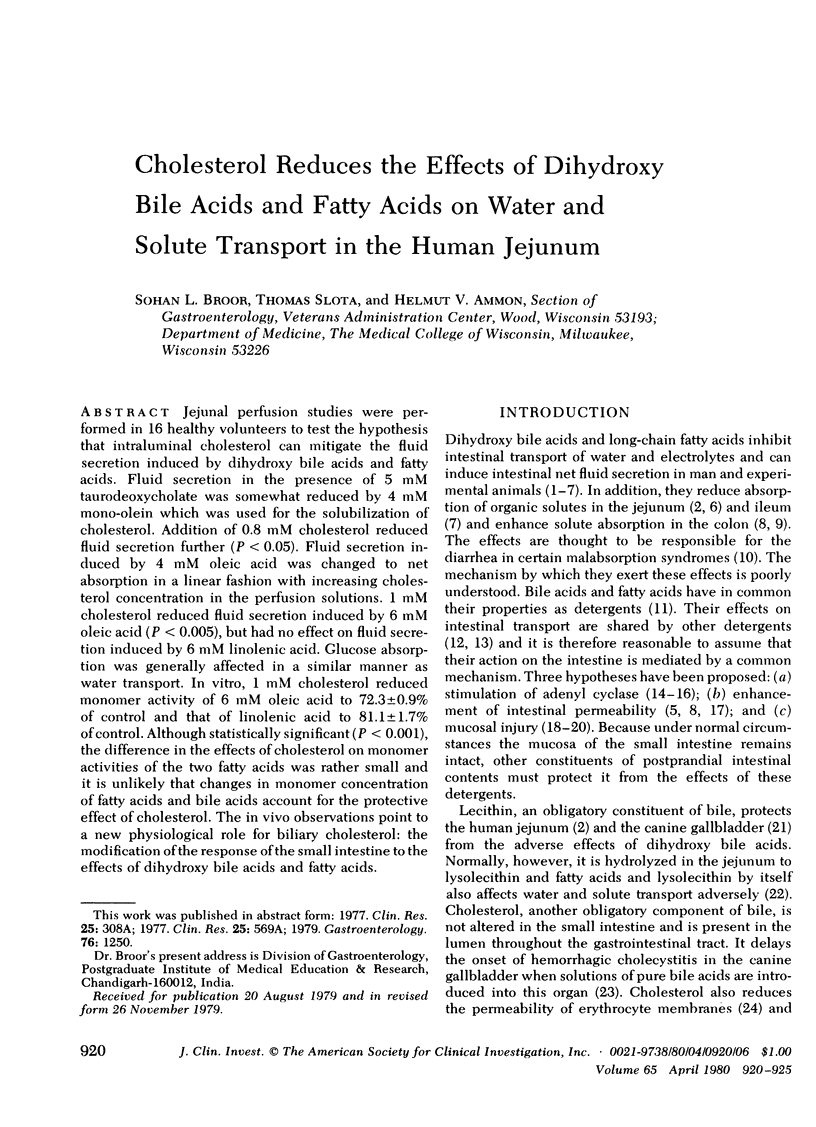
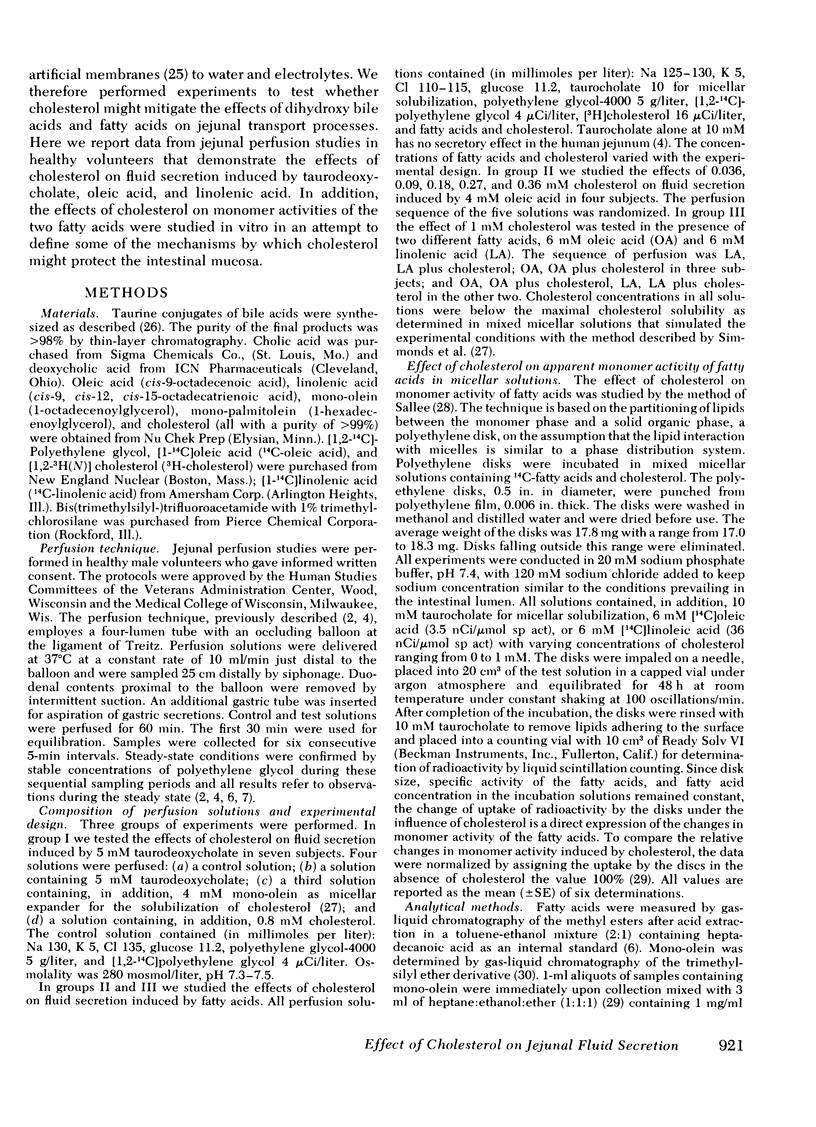
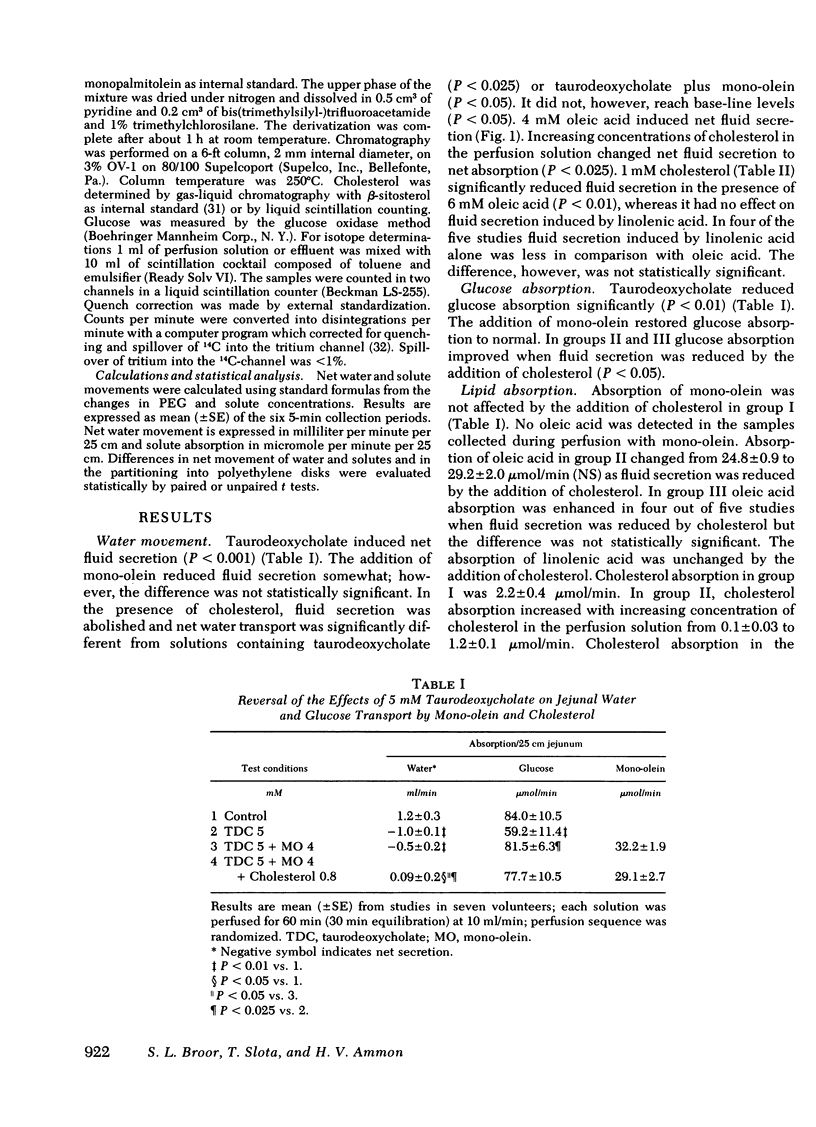
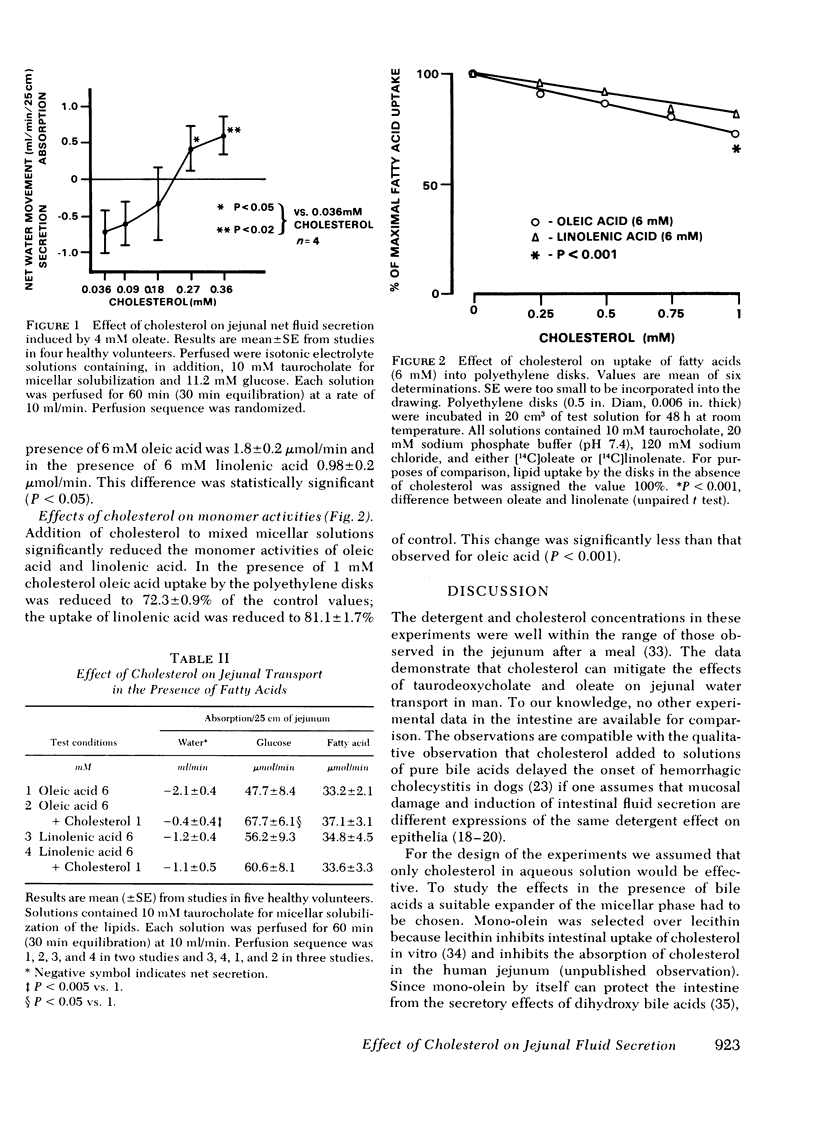
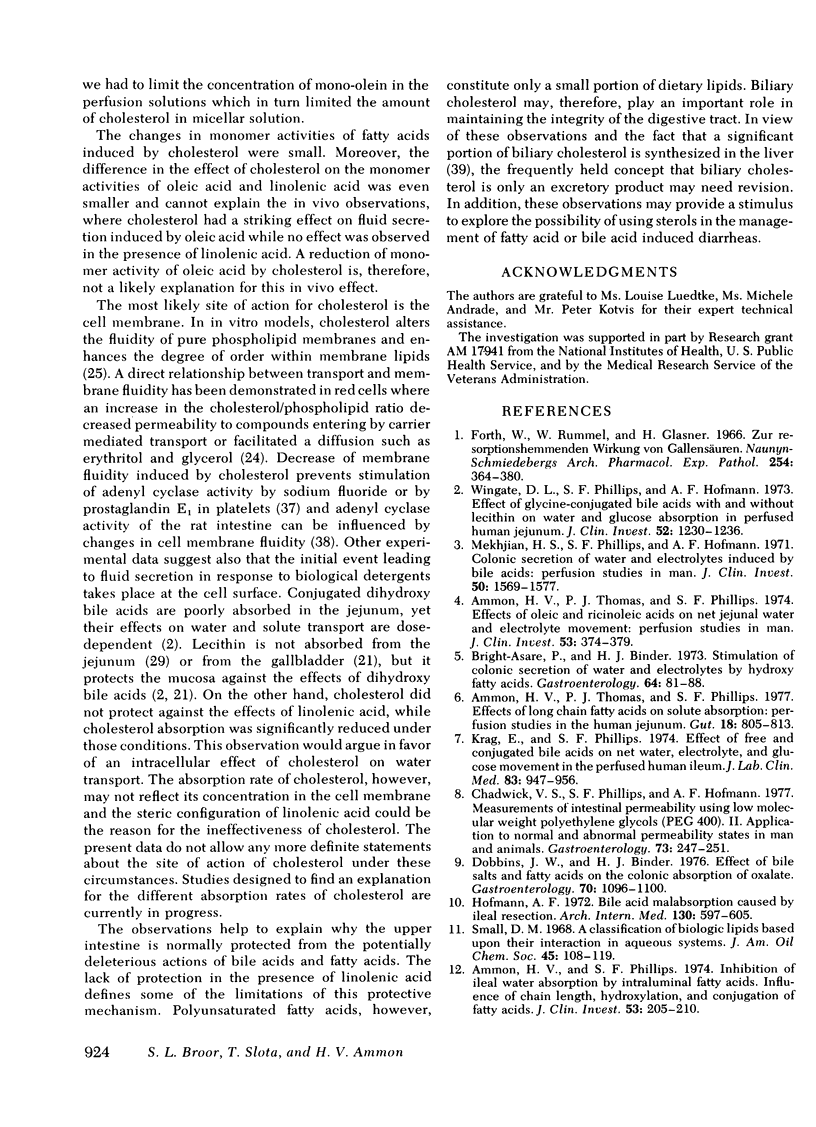
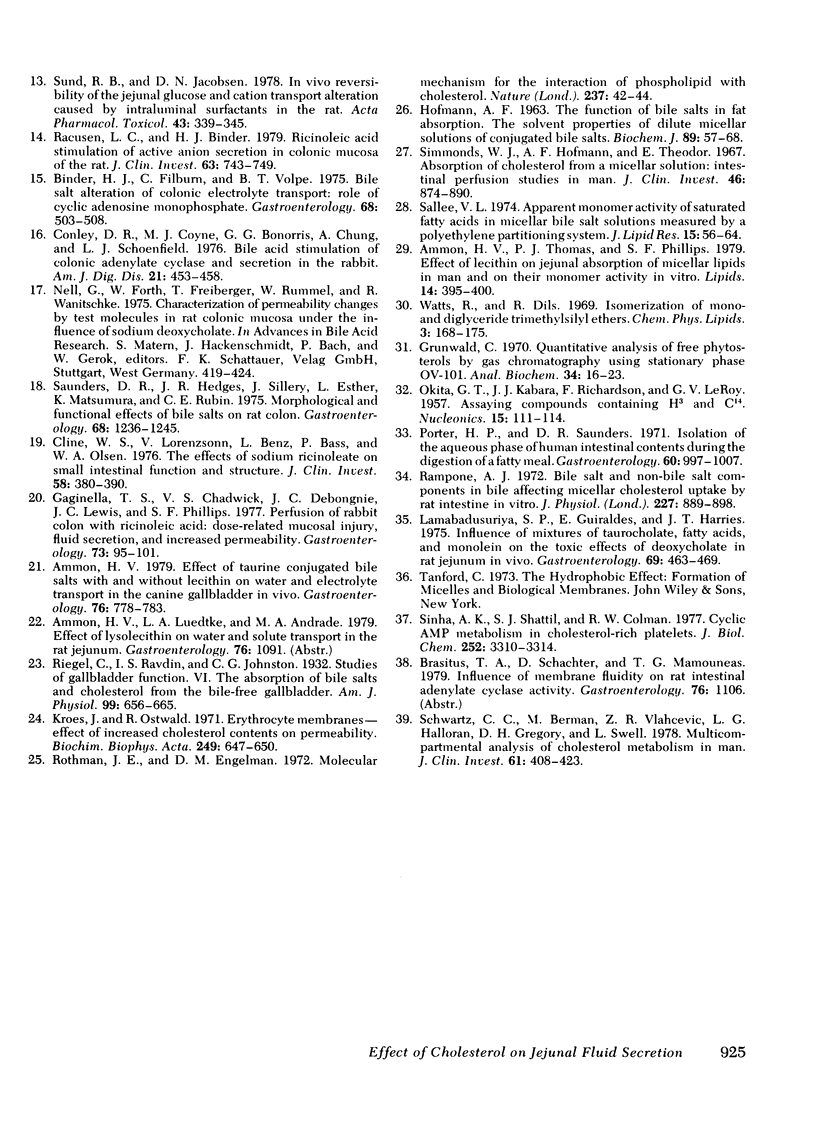
Selected References
These references are in PubMed. This may not be the complete list of references from this article.
- Ammon H. V. Effect of taurine conjugated bile salts with and without lecithin on water and electrolyte transport in the canine gallbladder in vivo. Gastroenterology. 1979 Apr;76(4):778–783. [PubMed] [Google Scholar]
- Ammon H. V., Phillips S. F. Inhibition of ileal water absorption by intraluminal fatty acids. Influence of chain length, hydroxylation, and conjugation of fatty acids. J Clin Invest. 1974 Jan;53(1):205–210. doi: 10.1172/JCI107539. [DOI] [PMC free article] [PubMed] [Google Scholar]
- Ammon H. V., Thomas P. J., Phillipis S. F. Effect of lecithin on jejunal absorption of micellar lipids in man and on their monomer activity in vitro. Lipids. 1979 Apr;14(4):395–400. doi: 10.1007/BF02533424. [DOI] [PubMed] [Google Scholar]
- Ammon H. V., Thomas P. J., Phillips S. F. Effects of long chain fatty acids on solute absorption: perfusion studies in the human jejunum. Gut. 1977 Oct;18(10):805–813. doi: 10.1136/gut.18.10.805. [DOI] [PMC free article] [PubMed] [Google Scholar]
- Ammon H. V., Thomas P. J., Phillips S. F. Effects of oleic and ricinoleic acids on net jejunal water and electrolyte movement. Perfusion studies in man. J Clin Invest. 1974 Feb;53(2):374–379. doi: 10.1172/JCI107569. [DOI] [PMC free article] [PubMed] [Google Scholar]
- Binder H. J., Filburn C., Volpe B. T. Bile salt alteration of colonic electrolyte transport: role of cyclic adenosine monophosphate. Gastroenterology. 1975 Mar;68(3):503–508. [PubMed] [Google Scholar]
- Bright-Asare P., Binder H. J. Stimulation of colonic secretion of water and electrolytes by hydroxy fatty acids. Gastroenterology. 1973 Jan;64(1):81–88. [PubMed] [Google Scholar]
- Chadwick V. S., Phillips S. F., Hofmann A. F. Measurements of intestinal permeability using low molecular weight polyethylene glycols (PEG 400). II. Application to normal and abnormal permeability states in man and animals. Gastroenterology. 1977 Aug;73(2):247–251. [PubMed] [Google Scholar]
- Cline W. S., Lorenzsonn V., Benz L., Bass P., Olsen W. A. The effects of sodium ricinoleate on small intestinal function and structure. J Clin Invest. 1976 Aug;58(2):380–390. doi: 10.1172/JCI108482. [DOI] [PMC free article] [PubMed] [Google Scholar]
- Conley D. R., Coyne M. J., Bonorris G. G., Chung A., Schoenfield L. J. Bile acid stimulation of colonic adenylate cyclase and secretion in the rabbit. Am J Dig Dis. 1976 Jun;21(6):453–458. doi: 10.1007/BF01072128. [DOI] [PubMed] [Google Scholar]
- Dobbins J. W., Binder H. J. Effect of bile salts and fatty acids on the colonic absorption of oxalate. Gastroenterology. 1976 Jun;70(6):1096–1100. [PubMed] [Google Scholar]
- Forth W., Rummel W., Glasner H. Zur resorptionshemmenden Wirkung von Gallensäuren. Naunyn Schmiedebergs Arch Pharmakol Exp Pathol. 1966;254(4):364–380. [PubMed] [Google Scholar]
- Gaginella T. S., Chadwick V. S., Debongnie J. C., Lewis J. C., Phillips S. F. Perfusion of rabbit colon with ricinoleic acid: dose-related mucosal injury, fluid secretion, and increased permeability. Gastroenterology. 1977 Jul;73(1):95–101. [PubMed] [Google Scholar]
- Grunwald C. Quantitative analysis of free phytosterols by gas chromatography using stationary phase OV-101. Anal Biochem. 1970 Mar;34:16–23. doi: 10.1016/0003-2697(70)90081-3. [DOI] [PubMed] [Google Scholar]
- HOFMANN A. F. THE FUNCTION OF BILE SALTS IN FAT ABSORPTION. THE SOLVENT PROPERTIES OF DILUTE MICELLAR SOLUTIONS OF CONJUGATED BILE SALTS. Biochem J. 1963 Oct;89:57–68. doi: 10.1042/bj0890057. [DOI] [PMC free article] [PubMed] [Google Scholar]
- Hofmann A. F. Bile acid malabsorption caused by ileal resection. Arch Intern Med. 1972 Oct;130(4):597–605. [PubMed] [Google Scholar]
- Krag E., Phillips S. F. Effect of free and conjugated bile acids on net water, electrolyte, and glucose movement in the perfused human ileum. J Lab Clin Med. 1974 Jun;83(6):947–956. [PubMed] [Google Scholar]
- Kroes J., Ostwald R. Erythrocyte membranes--effect of increased cholesterol content on permeability. Biochim Biophys Acta. 1971 Dec 3;249(2):647–650. doi: 10.1016/0005-2736(71)90147-7. [DOI] [PubMed] [Google Scholar]
- Lamabadusuriya S. P., Guiraldes E., Harries J. T. Influence of mixtures of taurocholate, fatty acids, and monolein on the toxic effects of deoxycholate in rat jejunum in vivo. Gastroenterology. 1975 Aug;69(2):463–469. [PubMed] [Google Scholar]
- Mekjian H. S., Phillips S. F., Hofmann A. F. Colonic secretion of water and electrolytes induced by bile acids: perfusion studies in man. J Clin Invest. 1971 Aug;50(8):1569–1577. doi: 10.1172/JCI106644. [DOI] [PMC free article] [PubMed] [Google Scholar]
- Porter H. P., Saunders D. R. Isolation of the aqueous phase of human intestinal contents during the digestion of a fatty meal. Gastroenterology. 1971 Jun;60(6):997–1007. [PubMed] [Google Scholar]
- Racusen L. C., Binder H. J. Ricinoleic acid stimulation of active anion secretion in colonic mucosa of the rat. J Clin Invest. 1979 Apr;63(4):743–749. doi: 10.1172/JCI109358. [DOI] [PMC free article] [PubMed] [Google Scholar]
- Rampone A. J. Bile salt and non-bile salt components in bile affecting micellar cholesterol uptake by rat intestine in vitro. J Physiol. 1972 Dec;227(3):889–898. doi: 10.1113/jphysiol.1972.sp010064. [DOI] [PMC free article] [PubMed] [Google Scholar]
- Rothman J. E., Engelman D. M. Molecular mechanism for the interaction of phospholipid with cholesterol. Nat New Biol. 1972 May 10;237(71):42–44. doi: 10.1038/newbio237042a0. [DOI] [PubMed] [Google Scholar]
- Sallee V. L. Apparent monomer activity of saturated fatty acids im micellar bile salt solutions measured by a polyethylene partitioning system. J Lipid Res. 1974 Jan;15(1):56–64. [PubMed] [Google Scholar]
- Saunders D. R., Hedges J. R., Sillery J., Esther L., Matsumura K., Rubin C. E. Morphological and functional effects of bile salts on rat colon. Gastroenterology. 1975 May;68(5 Pt 1):1236–1245. [PubMed] [Google Scholar]
- Schwartz C. C., Berman M., Vlahcevic Z. R., Halloran L. G., Gregory D. H., Swell L. Multicompartmental analysis of cholesterol metabolism in man. Characterization of the hepatic bile acid and biliary cholesterol precursor sites. J Clin Invest. 1978 Feb;61(2):408–423. doi: 10.1172/JCI108952. [DOI] [PMC free article] [PubMed] [Google Scholar]
- Simmonds W. J., Hofmann A. F., Theodor E. Absorption of cholesterol from a micellar solution: intestinal perfusion studies in man. J Clin Invest. 1967 May;46(5):874–890. doi: 10.1172/JCI105587. [DOI] [PMC free article] [PubMed] [Google Scholar]
- Sinha A. K., Shattil S. J., Colman R. W. Cyclic AMP metabolism in cholesterol-rich platelets. J Biol Chem. 1977 May 25;252(10):3310–3314. [PubMed] [Google Scholar]
- Small D. M. A classification of biologic lipids based upon their interaction in aqeous systems. J Am Oil Chem Soc. 1968 Mar;45(3):108–119. doi: 10.1007/BF02915334. [DOI] [PubMed] [Google Scholar]
- Sund R. B., Jacobsen D. N. In vivo reversibility of the jejunal glucose and cation transport alteration caused by intraluminal surfactants in the rat. Acta Pharmacol Toxicol (Copenh) 1978 Nov;43(5):339–345. doi: 10.1111/j.1600-0773.1978.tb02276.x. [DOI] [PubMed] [Google Scholar]
- Wingate D. L., Phillips S. F., Hofmann A. F. Effect of glycine-conjugated bile acids with and without lecithin on water and glucose absorption in perfused human jejunum. J Clin Invest. 1973 May;52(5):1230–1236. doi: 10.1172/JCI107290. [DOI] [PMC free article] [PubMed] [Google Scholar]


